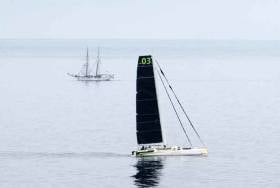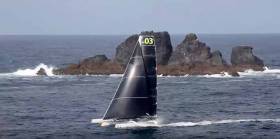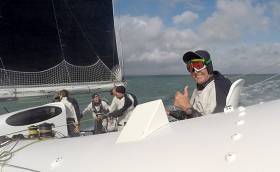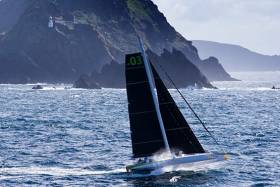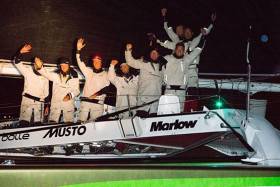Displaying items by tag: Phaedo 3
County Cork's Justin Slattery, a double Volvo Ocean Race Winner, and the rest of the Phaedo 3 crew are expected into Hawaii in the early hours of Tuesday am, hopefully with the WSSRC Transpacific Record in the bag.
As Afloat.ie reported earlier, they pulled out in the fog from the Long Beach dock in California last Friday morning. Lloyd Thornburg and his crew aboard Phaedo3 waited for several hours for the wind to fill in at Port Fermin, the boat took off at 21:40:15 (UTC) towards its final destination of Diamond Head in Hawaii.
The previous record was set by "Lending Club 2" back in July 2015 with a time of 3 days 18 hours & 9 seconds.
On board for the record attempt is: Lloyd Thornburg, Brian Thompson, Justin Slattery, David Swete, Peter Cumming, Fletcher Kennedy & Henry Bomby
You can follow them on the tracker here: my.yb.tl/Phaedo3/2262/
* News from Brian Thompson on board, we are expecting them into Hawaii in the early hours of Tuesday am:
"......It's been full on here, very hard to type anything since the start.. inside the last 500 miles and the record is still on if we keep the speed up.
Its blowing 25 knots with more in the squalls and we are tearing downwind towards Honolulu..
The first night was rough as expected with 30 knots plus on the beam and a big sea state. We had 3 reefs and the J3 which is our storm jib up most of the night.. we lost some time there but the second and 3rd day have been keeping up with a routing pace..
Everyone pushing hard to get this record, any off watch time is spent making some freeze dried food and trying to sleep inside this rally car going full speed..."
Ireland Considered Ceding Atlantic Rock To Portugal
A rocky Irish islet in the Atlantic, a steep little place where former Taoiseach Charlie Haughey and his family and friends once partied, faced being ceded to Portugal last autumn following close examination of current Round Ireland record footage.
Afloat.ie has learned that late last summer, an influential group had made approaches to Portugal in order to maintain the validity of the new Round Ireland Record as established by the MOD 70 Phaedo 3. The special group in Ireland was unaware that World Sailing Speed Records do not include the Great Foze Rock west of the Blaskets as being included in the round Ireland record course. In their enthusiasm to uphold the new record, the group was prepared to cede Irish territory to Portugal.
As a result, The Great Foze Rock – the furthermost outcrop of the Blasket Islands, and the most westerly part of Ireland after Rockall – was in future to be known as Grande Ilheu de Foze. And instead of being part of the Blaskets, it was to be included in the Arquipelago dos Acores (Azores Archipelago).
But further research revealed a slightly confused situation between the two main round Ireland sailing projects. The biennial Volvo Round Ireland Race from Wicklow simply states that the course is round Ireland clockwise, leaving Ireland and all her islands except Rockall to starboard, and it specifically names the Great Foze Rock and the nearby Little Foze Rock, as they are the most westerly marks of the Round Ireland Race course.
However, the Round Ireland Record as administered by the WSSR has a different set of rules (and a different course distance too, as they reckon it’s 698 miles, whereas from Wicklow it’s 704). The official record is started from a line off Dublin Bay between the Kish Lighthouse and the lighthouse on Dun Laoghaire South Pier, and you can go in either direction.
Going anti-clockwise like Phaedo 3, the officially-designated course is Rathlin Island, Tor Rock at Inishtrahull, Tory Island, Eagle Island, Tearaght Island, Great Skellig, Fastnet Rock, Coningbeg Rock, Tuskar Rock and finish.
Thus it looks as though WSSR does not think of the Great Foze Rock as being worthy of consideration as part of Ireland. But the people of Kerry need not feel personally offended by this, as up in County Antrim they have a similar grievance. The Maidens Rocks northeast of Larne, which are large enough to have a lighthouse and a couple of supporting houses, likewise aren’t mentioned as a Round Ireland Record mark of the course.
Be that as it may, the situation which highlighted the situation regarding the Great Foze arose early in August 2016, when the current record was being established. The superb film and photographic images of the record-breaking MOD 70 Phaedo 3 sweeping southwards past the Blasket Island of lighthouse-equipped Inishtearaght, then speeding on to pass to seaward of Skellig Michael, showed that in order to get the most dramatic images from being as close as possible to Inishtearaght, Phaedo 3 sailed inside the 27-metre high Great Foze Rock, which is 0.8 miles to the westward of Tearaght.
This is some of the finest footage ever shot of sailing off the Irish coast, with a couple of seconds showing Phaedo passing to the eastward of the great Foze Rock to position herself for a dramatic sail-past at Tearaght Island and the Great Skellig – followed remarkably quickly by the Fastnet itself, which was 60 miles further on.
This is no way lessened the total distance sailed to set the new record. But Round Ireland Race veterans – particularly those whose memories go back to pre-GPS days – will be well aware that staying clear outside the unmarked and unlit Great Foze was always something of a navigational challenge when sailing through what could be the roughest waters experienced on the entire course. Naturally, they were surprised to learn that this storm-tossed outcrop is not part of the Round Ireland Record course.
However, in the most windless and swell-free summer weather, it is just possible to land on The Great Foze. Many years ago, in admittedly almost unbelievably calm conditions, former Taoiseach Charlie Haughey with some family and friends zoomed out there aboard a RIB from their summer home on the Blasket Island of Inishvickillane, and managed to land on the Great Foze and have a bit of a party.
In the best traditions of Blaskets hospitality, when they headed for home they left behind a bottle of Cork Dry Gin and some glasses for the next visitors. But over the years, they never heard of anyone who had been able to enjoy the benefits of their thoughtful gesture.
Lloyd Thornburg’s Phaedo 3 Breaks Round Isle of Wight Record
Lloyd Thornburg’s Phaedo 3 set a new World Record time of 2 hours 4 minutes and 14 seconds around the Isle of Wight on Friday afternoon. Now the MOD70 holds both the World Record and Race Record. The boat itself held the old World record of 2 hours 21 minutes and 25 seconds, but that is when is was “Foncia” and being skippered by Michel Desjoyeaux. Record still to be ratified by the WSSRC.
Crew onboard for the race: Brian Thompson, Miles Seddon, Robert Greenhalgh, Peter Greenhalgh, Pete Cumming, Sam Goodchild, Fletcher Kennedy, Justin Slattery. Onboard media; Rachel Fallon-Langdon
The new post-Cowes Week 400-mile RORC Cowes-Wolf Rock-Ushant Race, which started from the Solent on Saturday, saw the return fresh as daisies of Lloyd Thornburg and his crew writes W M Nixon. They’d flown in from Dublin after dinner at the National YC on Friday night, where they were honoured for their new Round Ireland Record with the MOD 70 Phaedo 3.
The celebration clearly hadn’t taken a feather out of them, as on Saturday they zoomed down the English Channel at the head of the fleet to round Wolf Rock off Cornwall. Then they headed south to negotiate the extremely tricky rounding of Ouessant with its many offlying rocks and tide rips, before sailing on along the equally rocky north coast of Brittany to St Malo. There, they took line honours from sister-ship Concise 10 (Ned Collier Wakefield) at 1618hrs this (Monday) afternoon, and it will be some time before anyone else is along to challenge them, for as of 1830hrs Monday, the next in line, Piet Vroon’s Tonnere 4, is still in the process of rounding Ouessant.
As for the main body of the fleet, they’re bundling up to round Wolf Rock, the group including Ireland’s Michael Boyd owner-skippered JPK 10.80 Audrey, 19th overall in IRC and third in IRC Class 3, and Conor Fogerty’s Sunfast 3600 Bam from Howth, 25th overall and fifth in Class 3.
American skipper Lloyd Thornburg has set a new Round Ireland speed sailing record in his 70–foot trimaran Phaedo 3 just a month after a new record was made by rival MOD 70 Oman Sail. Phaedo 3, with Ireland's leading offshore sailor Damian Foxall on board, crossed the Kish lighthouse finish line at Dún Laoghaire, at 04.01.04am this morning (Friday, 5th August 2016), beating the previous world record by approximately 1 hours and 45 minutes. The time has still to be ratified by the World Speed Sailing Record Council.
Thornburg and his crew, including Ireland’s Damian Foxall, set off from Dún Laoghaire on Wednesday at 15.09.00 returning 36 hours and 52 minutes later.
The previous world record of 38 hours, 37 minutes and 7 seconds was set by Musandam Oman-Sail in last June’s Volvo Round Ireland Yacht Race.
The latest record comes just weeks after Lloyd and his Phaedo 3 crew won the Round Island Race in the UK, smashing Sir Ben Ainslie’s record, and setting a new record of just 2 hours 23 minutes and 23 seconds, for round the Isle of Wight.
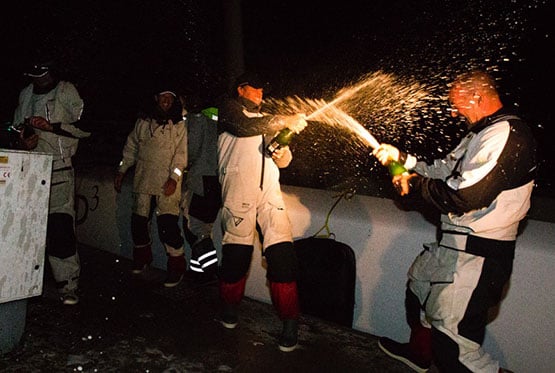 Round Ireland Phaedo 3 Record breakers celebrate at Dun Laoghaire marina. Photo: Rachel Fallon Langdon
Round Ireland Phaedo 3 Record breakers celebrate at Dun Laoghaire marina. Photo: Rachel Fallon Langdon
Back ashore at Dun Laoghaire, Thornburg said the crew was exhausted but it was worth every second. “You really appreciate how beautiful this island is when you see it from the coast-side. The first time we came here was when we took part in the Volvo Round Ireland Yacht race last June. We had to come back and do it again and setting a new world record made it all the more worthwhile. It was intense but we’d do it again tomorrow, and we will be back!”
Celebrations will be short-lived however as Lloyd and the crew will be heading straight to the UK for the 2016 Cowes regatta, which kicks off tomorrow, Saturday.
The record-setting crew on board for the record were: Lloyd Thornburg - helm, Brian Thompson - Co-Skipper, Miles Seddon - Navigator, Damian Foxall - Bow, Paul Allen - Trim, Sam Goodchild - Trim, Henry Bomby - Grinder, Fletcher Kennedy - Grinder
Phaedo 3, hitting speeds of over 30–knots, made spectacular time covering two thirds of the northabout voyage from Dublin in a record time but things slowed dramatically in the closing stages yesterday evening when speeds dropped after rounding Tuskar Rock. Speeds as low as three knots brought the tri home past the Wexford coast and the estimated midnight arrival time slipped by with no finisher. Thornburg entered Dublin Bay at 4am, cutting things quite fine at the end.
Although the Round Ireland speed sailing record stood for nearly 22 years, clearly something very special indeed is happening in the Record Breaking Dept in 2015/16 when it is broken three times in little over a year.
Sidney Gavignet and the skipper of Oman Sail broke the 44–hour time set by Steve Fossett's 60ft trimaran Lakota in 1993 that withstood several challenges, including three by top French skipper Gavignet.
The OmanSail MOD 70 finally broke it with a time of just over forty hours in May 2015. Gavignet was back on Irish waters a year later as part of June's three–way MOD division of the Round Ireland Race. With some very exciting sailing on the 700–mile route, he broke his own record with a new sub 40–hour time of just over 38 hours.
Now that the Omani/French record has fallen to an American entry, how long will it be before another attempt is made at what is a very international dimension to Irish sailing?


























